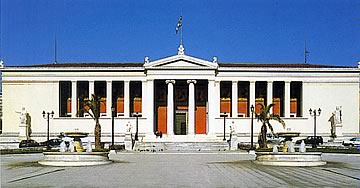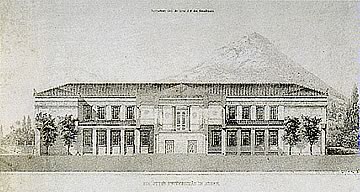
University of Athens (National Capodistrian University)
30 Panepistimiou St, Athens, 1839-1864
Architect
Hans Christian Hansen (1803-1873)
The University of Athens (National Capodistrian University),
the first of the "Athenian Trilogy", is one of the top-ranking
works of neohellenic classicism, but also one of the main models for
the academic tradition of public buildings in Athens. Construction was
begun in 1839 using the proceeds of a fund-raising campaign from Greeks
at home and abroad, and was not completed until 1864 owing to inadequate
funds.
The building consists of three different wings that are in the shape
of a double-T on plan. Supplemented by its two lateral courtyards, it
is enclosed in a rectangle. The ground floor contains four chambers
in the front wing, areas for the administration and secretariat in the
middle and two amphitheatres in the back wing. On the upper floor of
the front wing is the library, in the middle wing is the ceremonial
hall and the back wing houses the Natural History Museum.
The building as a whole has a simple, neoclassical line and grandeur.
The façade is symmetrically articulated with a projecting Ionic
porch on the axis, a colonnade with ordinary piers on each side, and
solid sections at the edges. The frieze on the colonnade is adorned
with a work drawn by the Bavarian artist Karl Rahl and painted by the
Polish artist Lembietsky on the theme of the renaissance of the fine
arts and sciences in Greece under King Otho.
The main virtues of Christian Hansen’s neoclassical building are
its simple plastic and chromatic treatment and its human scale.
TRANSPORTATION

